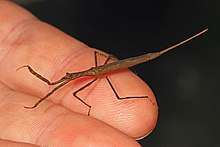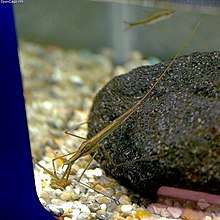Ranatra
Ranatra is a genus of slender predatory insects of the family Nepidae, known as water scorpions or water stick-insects.[1] There are around 100 Ranatra species found in freshwater habitats around the world, both in warm and temperate regions, with the highest diversity in South America (almost 50 species) and Asia (about 30 species). Fewer are found elsewhere, but include several African, some in North America, three from Australia and three from the Palearctic, notably the relatively well-known European R. linearis.[2] These brown insects are primarily found in stagnant or slow-moving water like ponds, marshes and canals, but can also be seen in streams.[2] Exceptionally they have been recorded from hypersaline lakes and brackish lagoons.[3]


| Ranatra | |
|---|---|
 | |
| Ranatra chinensis | |
| Scientific classification | |
| Kingdom: | Animalia |
| Phylum: | Arthropoda |
| Class: | Insecta |
| Order: | Hemiptera |
| Family: | Nepidae |
| Genus: | Ranatra Fabricius, 1790 |
Their front legs are strong and used to grasp prey. They typically eat other insects, tadpoles and small fish, which they pierce with their proboscis and inject a saliva which both sedates and begins to digest their prey. They are sit-and-wait predators that reside among water plants and position themselves head-down with their grasping legs extended out to surprise passing prey.[2] At least one species will also swim in open water at night to catch zooplanktonic organisms.[4] Like other members in the family they have a long tail-like siphon, or breathing tube, on the rear end of their body.[4] The adult body length is generally 2–6 cm (0.8–2.4 in) depending on the exact species, and females average larger than males of the same species. The siphon is typically almost the same size, but varies from less than half the body length to somewhat longer. Two of the largest species are the East Asian R. chinensis and South American R. magna.[2][5] Ranatra do have wings and they can fly.[3]
The adults are active year-round, except in extreme cold. Their eggs are positioned on plants just below the water surface, but in some species they can be placed in mud.[2] The eggs typically take two to four weeks to hatch and the young take about two months to mature.
Among the four genera in the Ranatrinae subfamily, Austronepa and Goondnomdanepa are restricted to Australia. Cercotmetus from Asia to New Guinea resembles Ranatra, although the former has a distinctly shorter siphon.[2]
Species
These species belong to the genus Ranatra:
- Ranatra australis Hungerford, 1922 i c g b (southern water scorpion)
- Ranatra brevicollis Montandon, 1910 i c g b
- Ranatra buenoi Hungerford, 1922 i c g b
- Ranatra chinensis Mayr, 1865 g
- Ranatra drakei Hungerford, 1922 i c g
- Ranatra fabricii Guerin-Meneville, 1857 g
- Ranatra falloui Montandon, 1907 g
- Ranatra fusca Palisot, 1820 i c g b (brown waterscorpion)
- Ranatra galantae Nieser, 1969 g
- Ranatra incisa Chen Nieser & Ho, 2004 g
- Ranatra kirkaldyi Torre-bueno, 1905 i c g b
- Ranatra linearis (Linnaeus, 1758) i c g
- Ranatra macrophthalma Herrich-Schaffer, 1853 g
- Ranatra mediana Montandon, 1910 g
- Ranatra mixta Montandon, 1907 g
- Ranatra montezuma Polhemus, 1976 i c g
- Ranatra nigra Herrich-Schaeffer, 1849 i c g
- Ranatra obscura Montandon, 1907 g
- Ranatra quadridentata Stål, 1862 i c g b
- Ranatra subinermis Montandon, 1907 g
- Ranatra texana Hungerford, 1930 i c g
- Ranatra tuberculifrons Montandon, 1907 g
- Ranatra unicolor Scott, 1874 g
Data sources: i = ITIS,[6] c = Catalogue of Life,[7] g = GBIF,[8] b = Bugguide.net[9]
References
- www.itis.gov/
- P. Chen; N. Nieser; J.Z. Ho (2004). "Review of Chinese Ranatrinae (Hemiptera: Nepidae), with descriptions of four new species of Ranatra Fabricius". Tijdschrift voor Entomologie. 147 (1): 81–102. doi:10.1163/22119434-900000142.
- Ye.V. Anufriyeva; N.V. Shadrin (2016). "First Record of Ranatra linearis (Hemiptera, Nepidae) in Hypersaline Water Bodies of the Crimea". Hydrobiological Journal. 52 (2): 56–61.
- Dean W. Blinn; Chris Pinney; Milton W. Sanderson (1982). "Nocturnal Planktonic Behavior of Ranatra montezuma Polhemus (Nepidae: Hemiptera) in Montezuma Well, Arizona". Journal of the Kansas Entomological Society. 55 (3): 481–484.
- Heckman, C.W. (2011). Encyclopedia of South American Aquatic Insects: Hemiptera - Heteroptera. Springer. ISBN 978-94-007-0704-7.
- "Ranatra Report". Integrated Taxonomic Information System. Retrieved 2018-04-28.
- "Browse Ranatra". Catalogue of Life. Retrieved 2018-04-28.
- "Ranatra". GBIF. Retrieved 2018-04-28.
- "Ranatra Genus Information". BugGuide.net. Retrieved 2018-04-28.